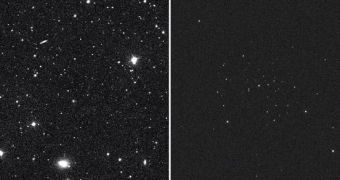So far, this seems to be the dimmest galaxy in the universe ever discovered. Shining only with the brightness of less than 350 suns, which is very little for an entire galaxy, it is believed to be filled with dark mater in enormous quantities.
Segue 1, as it is called, is one of only about 2 dozen dwarf galaxies orbiting the Milky Way. It is located near the Sagittarius stream, a flow of stellar debris seemingly torn from another galaxy of this type. In such objects, dark matter is more present than normal matter by a factor ranging between 100 and 1000. By comparison, Milky Way's regular matter is only outweighed by dark matter by a factor of 10. This makes objects like Segue 1 the perfect place to look for evidence related to dark matter existence.
Beth Willman from Haverford College in Pennsylvania, a member of the team that made the discovery, explains: "These galaxies are basically invisible. We didn't know these kinds of galaxies existed until a couple of years ago." That was the point when large surveys like the Sloan Digital Sky Survey started to indicate the presence of these galaxies.
Because of its dimness, astronomers first believed it was a globular cluster, a group of stars bound together. But Marla Geha from Yale University and her colleagues' further observations eventually indicated it was a dwarf galaxy. Only 24 stars were uncovered so far in Segue 1 and their measured velocity was of about 5 km/s (3.1 miles per second) , which is 10 times faster than if they were only bound to each other gravitationally. In order for them not to fly off at such speeds, they must be heavily surrounded by matter.
The galaxy's weight has been calculated to be at least that of 450.000 suns or 20 times that amount (9.000.000 suns) in case Segue 1 is as large as a normal dwarf galaxy. Observations indicate there's little gas present in the system, which means all the rest of the mass is made out of dark matter. As Geha told New Scientist, "It is the most dark matter-dominated galaxy in the universe."

 14 DAY TRIAL //
14 DAY TRIAL //